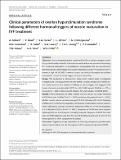Files in this item
Clinical parameters of ovarian hyperstimulation syndrome (OHSS) following different triggers of oocyte maturation in IVF treatment
Item metadata
| dc.contributor.author | Abbara, A. | |
| dc.contributor.author | Islam, R. | |
| dc.contributor.author | Clarke, S. A. | |
| dc.contributor.author | Jeffers, L. | |
| dc.contributor.author | Christopoulos, G. | |
| dc.contributor.author | Comninos, A. N. | |
| dc.contributor.author | Salim, R. | |
| dc.contributor.author | Lavery, S. A. | |
| dc.contributor.author | Vuong, T.N.L. | |
| dc.contributor.author | Humaidan, P. | |
| dc.contributor.author | Kelsey, T. W. | |
| dc.contributor.author | Trew, G.H. | |
| dc.contributor.author | Dhillo, W.S. | |
| dc.date.accessioned | 2018-03-06T12:30:07Z | |
| dc.date.available | 2018-03-06T12:30:07Z | |
| dc.date.issued | 2018-06 | |
| dc.identifier | 252288483 | |
| dc.identifier | e4d671cb-9255-4415-bd80-9deee53a576f | |
| dc.identifier | 85043321414 | |
| dc.identifier | 000434078900020 | |
| dc.identifier.citation | Abbara , A , Islam , R , Clarke , S A , Jeffers , L , Christopoulos , G , Comninos , A N , Salim , R , Lavery , S A , Vuong , T N L , Humaidan , P , Kelsey , T W , Trew , G H & Dhillo , W S 2018 , ' Clinical parameters of ovarian hyperstimulation syndrome (OHSS) following different triggers of oocyte maturation in IVF treatment ' , Clinical Endocrinology , vol. 88 , no. 6 , pp. 920-927 . https://doi.org/10.1111/cen.13569 | en |
| dc.identifier.issn | 0300-0664 | |
| dc.identifier.other | ORCID: /0000-0002-8091-1458/work/42504521 | |
| dc.identifier.uri | https://hdl.handle.net/10023/12859 | |
| dc.description | This paper presents independent research funded by grants from the MRC, BBSRC and NIHR and supported by the NIHR Clinical Research Facility and Biomedical Research Centre at Imperial College Healthcare NHS Trust. | en |
| dc.description.abstract | Objective. Ovarian hyperstimulation syndrome (OHSS) is a serious iatrogenic condition, predominantly related to the hormone used to induce oocyte maturation during IVF treatment. Kisspeptin is a hypothalamic neuropeptide that has recently been demonstrated to safely trigger final oocyte maturation during IVF treatment even in women at high risk of OHSS. However to date, the safety of kisspeptin has not been compared to current hormonal triggers of oocyte maturation. Design. We conducted a retrospective single-centre cohort study investigating symptoms and clinical parameters of early OHSS in women at high risk of OHSS (antral follicle count or total number of follicles on day of trigger ≥23) triggered with hCG (n=40), GnRH agonist (GnRHa; n=99), or kisspeptin (n=122) at Hammersmith Hospital IVF unit, London, UK (2013-2016). Results. Clinical Parameters of OHSS: Median ovarian volume was larger following hCG (138mls) than GnRHa (73mls; P<0.0001), and in turn kisspeptin (44mls; P<0.0001). Median ovarian volume remained enlarged 20-fold following hCG, 8-fold following GnRHa and 5-fold following kisspeptin compared to pre-stimulation ovarian volumes. Mean (±SD) ascitic volumes were lesser following GnRHa (9±44mls) and kisspeptin (5±8mls) than hCG (62±84mls; p<0.0001). Symptoms of OHSS were most frequent following hCG and least frequent following kisspeptin. Diagnosis of OHSS: The odds ratio for OHSS diagnosis was 33·6 (CI 12·6-89·5) following hCG and 3·6 (CI 1·8-7·1) following GnRHa, when compared to kisspeptin. Conclusion. Triggering oocyte maturation by inducing endogenous gonadotropin release is preferable to the use of exogenous hCG in women at high risk of OHSS. | |
| dc.format.extent | 8 | |
| dc.format.extent | 425992 | |
| dc.language.iso | eng | |
| dc.relation.ispartof | Clinical Endocrinology | en |
| dc.subject | GnRH agonist | en |
| dc.subject | hCG | en |
| dc.subject | IVF | en |
| dc.subject | Kisspeptin | en |
| dc.subject | Ovarian Hyperstimulation Syndrome | en |
| dc.subject | QA75 Electronic computers. Computer science | en |
| dc.subject | RG Gynecology and obstetrics | en |
| dc.subject | NDAS | en |
| dc.subject.lcc | QA75 | en |
| dc.subject.lcc | RG | en |
| dc.title | Clinical parameters of ovarian hyperstimulation syndrome (OHSS) following different triggers of oocyte maturation in IVF treatment | en |
| dc.type | Journal article | en |
| dc.contributor.institution | University of St Andrews. School of Computer Science | en |
| dc.contributor.institution | University of St Andrews. Centre for Interdisciplinary Research in Computational Algebra | en |
| dc.identifier.doi | 10.1111/cen.13569 | |
| dc.description.status | Peer reviewed | en |
This item appears in the following Collection(s)
Items in the St Andrews Research Repository are protected by copyright, with all rights reserved, unless otherwise indicated.

